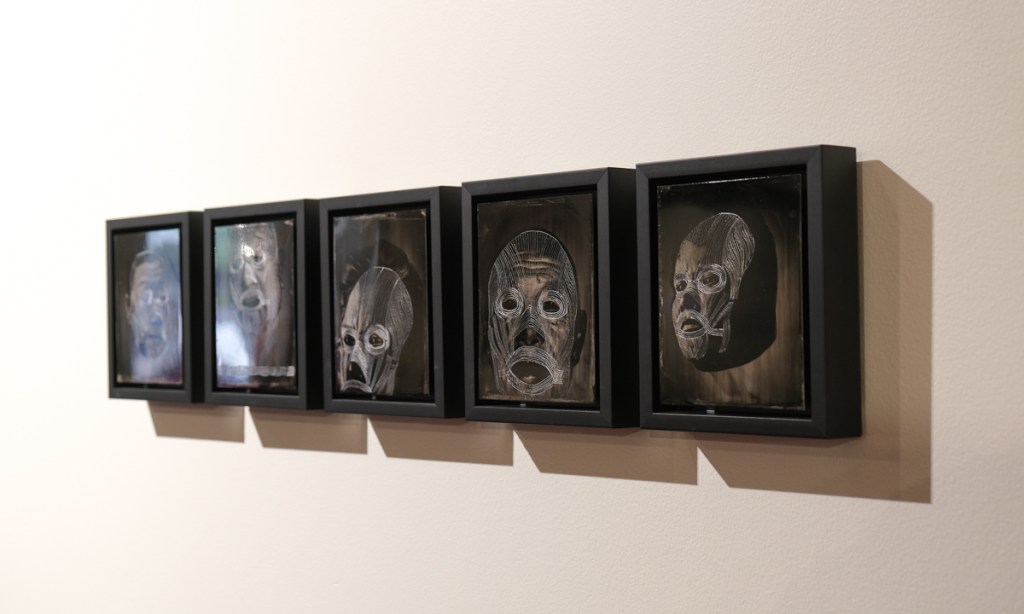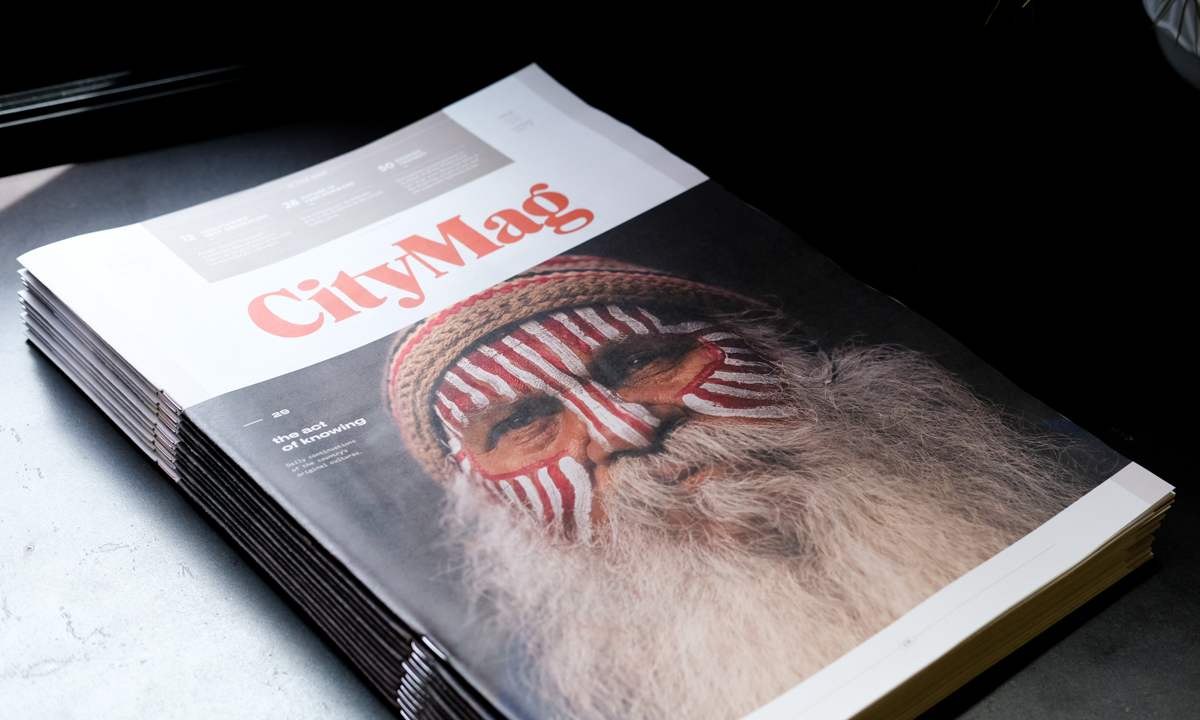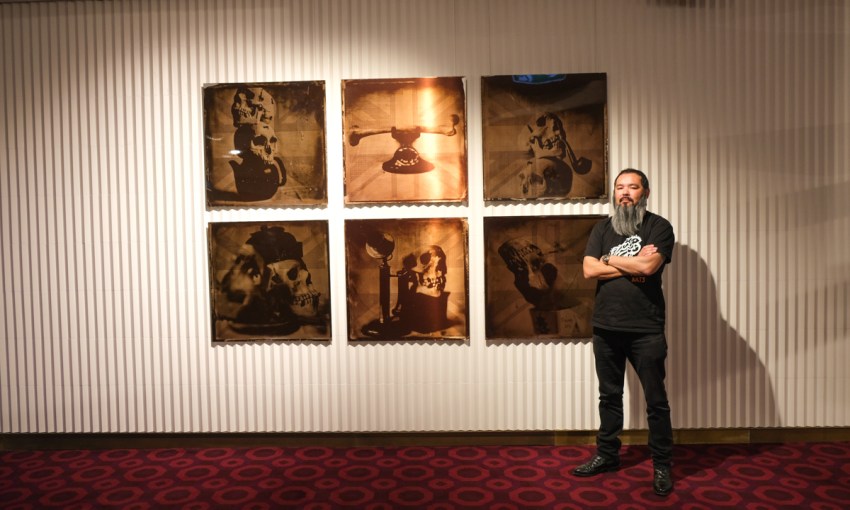CityMag sat down with multidisciplinary Ngarrindjeri artist Damien Shen to talk about his upbringing and what it means to be an Aboriginal and Chinese person.
Yellah Fellah explores stories through Aboriginal and Asian lens
Shen is deeply connected to his Aboriginal and Chinese backgrounds and says his Chinese heritage played a massive role in his childhood.
“Without the Chinese side, I’m not exactly sure where I would be today,” Damien says.
Damien’s dad was born in Hong Kong but was sent to boarding school in Adelaide.
“My grandparents thought the communists would come and take Hong Kong fairly quickly. So his sister got sent somewhere else and then he got sent to Australia,” Damien says.

Damien Shen, installation view of etched tintypes. © the artist
Born in Adelaide, Damien says his grandparents, who lived next door, were important characters in his childhood.
“I think the thing about the Chinese side, which I appreciate more as I get older, is just the structure that they were able to put in place,” Damien says.
“There [were] a few things going on in my dad’s life and whatnot.
“My Chinese grandmother saw it as her role to keep the home structured — breakfast would come out at a certain time, dinner was always at six o’clock at night. They provided a safe structure for the kids.”
Although Damien is proud of his Chinese heritage, he admits it was challenging growing up with undeniable racism towards Asian people in Australia.
“I didn’t speak Chinese because my dad came over at a time where there was a lot of racism so he was just like ‘nah you’re speaking English’ and he wouldn’t encourage us speaking,” Damien says.
“At home he spoke Cantonese, my grandparents spoke Cantonese and Mandarin and Shanghainese, and then English to us around the table.”
Damien recalls his first job at a Chinese restaurant and says “because you don’t know the language, it’s harder to fit in”.
“I was known as this guy who had long hair, didn’t speak Chinese, and almost a little bit of a novelty for the Chinese,” he says.
“I was sort of there but never really connected.”

Elder Major ‘Moogy’ Sumner (Uncle Moogy) featured on the cover of our nineteenth edition of CityMag. This picture: Lauren Bezzina.
Damien’s mums side, his Aboriginal heritage, was pivotal in his childhood as well.
“Growing up, I always knew I was part of the Aboriginal community and [had] a lot of cousins and spent a lot of time with them,” Damien says.
“My family member is Uncle Moogy, who everyone knows — that’s my mum’s brother. So that’s actually my real uncle. Everyone calls him Uncle Moogy.
“Growing up with him, he’d always have a lot of kids at his house, so we’d always just do sleepovers there, and so that was always really fun and very memorable.
“I still have a really close relationship with him now.”
Despite now appreciating his Aboriginal and Chinese heritage, there were still struggles, particularly when he was younger.
“When I was younger, up until probably about year 10 at school, I copped heaps of racism either on the Asian side or Aboriginal side — basically [they] had two ways to get me,” Damien says.
“Then I changed school and it instantly changed, because I went to a very multicultural school. All of a sudden, I didn’t have the pressure of standing out like that.”
It wasn’t until Damien was older that he began to research his Aboriginal heritage.
“As you get older, you start to think more about genealogy and history and stuff… when you look at the genealogy side of what it means to be an Aboriginal person connected to a family, it’s so fascinating,” he says.
“Anyone you’d meet, you’d call each other cuz, but you wouldn’t quite know how far removed — are we actually cousins?
“Then, on the other hand, you see the political side of what it means to be an Aboriginal person, the historical side, the things that happen to Ngarrindjeri, and so part of my work talks to that.”
Damien reflects on his life with two different backgrounds and feels blessed.
“I’m very fortunate to be able to have an experience through two lenses,” he says.
“Dual identity, or dual background — it’s an interesting thing.
“Looking like the way I do, you don’t always fit into an Aboriginal community environment, especially more so when I was younger I felt that.
“As I’m getting older, I know so many more Asian-Aboriginal people and we all sort of look the same.”

Damien Shen, Portraits, charcoal and pastel on paper, 2014. © the artist
Curated by Catherine Croll, art exhibition Yellah Fellah is currently on show at Adelaide Festival Centre for OzAsia. It displays work from four different artists with both Asian and Aboriginal heritage in a captivating and inspiring exhibition.
Damien, along with artists Gary Lee, Caroline Oakley and Jason Wing, have contributed their work to display their personal interpretation of their backgrounds through art form.
“Essentially, it’s the coming together of a number of artists with Asian and Aboriginal heritage,” Damien says.
“For me it’s Chinese and Aboriginal and I guess artists who are proud of that biracial mix.
“I won’t speak on behalf of any of the other artists… having the Chinese and Aboriginal heritage is something I’ve been incredibly proud of.
“In South Australia, you don’t get as many Aboriginal Chinese people as you would say up north in Darwin, there’s bigger mix of Asian Aboriginal cultural mix, but I’ve felt reasonably unique here for a while so it’s been pretty cool.”
According to curator Catherine, Asian Australian relations began centuries prior to Europeans colonising Australia. Aboriginal people across the Top End began trading networks with Malaysian trepangers, which then stretched right back to China.

Damien Shen, Life After Pen, 2017, tintype. © the artist
Titled Life After Pen, Damien created tin type pieces of skulls, which are pictured above, when in Virginia at an anatomy lab
“The history of theft of remains — a lot of Ngarrindjeri remains were stolen and sent overseas. Uncle Moogy’s been hugely influential with a whole bunch of Aboriginal leaders to travel overseas and repatriate those remains,” Damien says.
“The work here talks to that idea.
“The images with myself and Uncle Moogy deliberately shot in that sort of ethnographic way, that’s like a real classic style of how things were documented at a certain point in time, sort of plays on that history.”
Artwork titled Portraits, which was CityMag’s personal favourite, are black and white portrayals of Damien’s grandparents, sister and uncle.
“I got inspired [and] did a drawing workshop with an American guy, I thought ‘I wouldn’t mind documenting the stories of all my mum’s side’,” Damien says.
“Then on the other side, I thought ‘I’ll document my Chinese grandparents, and my sister as part of this series as well, just to have that Chinese element connected’.”
Yellah Fellah for OzAsia is on show at the Adelaide Festival Centre until this Sunday.
Connect with OzAsia on Instagram for more.




